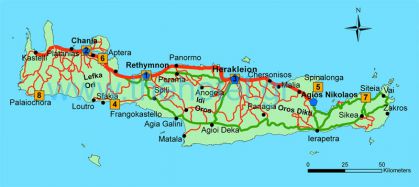1) Rethymno (Fortezza Fortress)
One of the largest Venetian castles is located at the place where the ancient acropolis was, overlooking the sea and the town. This fortress was built from 1573 till 1580 by the Venetians, for the protection of the inhabitants by the Turkish threat and the pirate raids. During the battle with the Turks the fortress could not resist the gigantic canon of the Ottoman Empire and finally it collapsed. Its geometry looks like star with three gates and six bastions. In the middle of the walls there was the church of St Nicolo, which later turned into the Mosque of the Sultan Ibrahim Han. There were also the Commander's house, the Counsellor's house, barracks, stables, ammunition - storehouses, a cistern and houses which were later destroyed. Some years earlier, the 13th Ephorate of Byzantine Antiquities made works of restoration and consolidation.
2) Chania Venetian Fortress
The Firkas Bastion is located at the western end of the outer harbour and today it houses the Naval Museum. It was built by the Venetians (with the walls perimetrically of the hill) to protect the town inside the walls from Turks and the corsairs. Eleftherios Venizelos and King Constantine officially raised the Greek flag here in 1913. During the summer months, the Firkas bastion is host to concerts and plays.
3) Heraklion Venetian Fortress
It was built by the Venetians to protect the city from Turks and Corsairs. When the city passed in the Venetians' hands they improved on the ditch which surrounded the city by building enormous fortifications, most of which are still in place, including a giant wall (up to 40m thick with 7 bastions) and the fortress in the harbour. The city fell to Turks after a 22-year siege in a bloody war in which 30,000 Cretans and 120,000 Turks died in 1669.
4) Frangokastello
The castle was built by the Venetians to protect the south coast of Crete from the Saracens pirates. It is famous since it is related to the 1821 (18th May) battle that took place between few Cretans and the Turkish army. A small force of six hundred brave Cretan men was slaughtered, along with their leader, Hadjimichalis Dalianis when he chose to remain inside the castle wall. Dalianis was beheaded and his head sent to the Turkish Pasha. The bones of the soldiers are said to be below the sand that comprises the floor of the castle. According to the legend the ghosts of the rebels appear every year on the 17th of May and walk from the sea towards the fortress to reclaim it.
5) Spinalonga
It was built by the Venetians in 1579 to control the entrance to the Gulf of Mirabello. It was one of the strongest castles in Crete and during the 17th century it was a refuge for Christians fleeing from the Turks. Finally in 1715 it fell in the hands of Turks by treaty (Irakleion had already fallen by 1669). It was used as a leper colony after the Turks left the island. Today several daily boat trips from Agios Nikolaos visit the island.
The name of the island is of linguistic interest. The word Spinalonga is Italian and means long thorn (Spina-longa). The Venetians called it so because they adapted to their own language a Greek composite word "Stinelounda" meaning "to Elounda" (sten-Elounda).
6) Aptera Castle
Aptera Turkish fortress is located on a hilltop near the ruins of Byzantine Aptera. The view is magnificent on the whole Souda peninsula.
7) Venetian Fortress, Siteia
It was built by the Venetians to protect the island from Turks. It resisted three years siege in 1648-51. The Venetian fortress "Kazarma" (named after the Italian caserma -barracks) overlooks Sitia and plays host to several concerts and other performance events-plays during the July and August.
8) Venetian Paleochora Castle
It was built in 1279 to control the southwest of Crete against the corsairs. It was destroyed by the Turkish corsair Barbarossa in 1539. The outside of the fortress is well preserved until today. It has named after the town which is located there.



